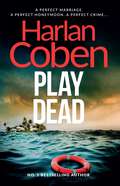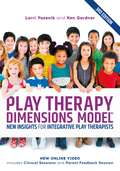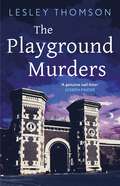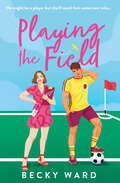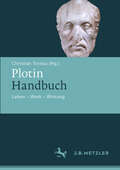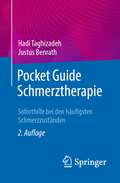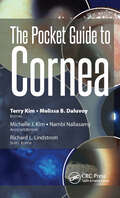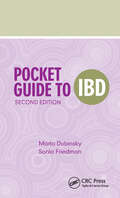- Table View
- List View
Plant Names Explained: Botanical Terms and Their Meaning
by Editors of Editors of David & CharlesIf you, like many gardeners, have a fascination for plant names and their derivations, but stop short of wanting to study botanical nomenclature in great depth, this book is for you!Precise naming is essential to be able to identify plants accurately and most gardeners have at least some knowledge of ‘botanical Latin’. But a plant’s full botanical name does much more than give it a unique label. The name can often tell you where the plant originated, who discovered it, what shape it is, and much else besides. What’s more, the name can be used and understood anywhere in the world.This is a book to have with you at the garden centre, and one to keep beside your bed for an entertaining read. Plant Names Explained is an indispensable guide and makes the subject accessible, enjoyable and fun. It shows not only how plant names work, but also how you can make use of them in entertaining as well as practical ways.A selective alphabetical listing of botanical names and their explanations is accompanied by features exploring cultivar names, with translations of foreign terms and lists of plants you can link with special occasions and celebrations, or with personal names. Other features highlight the places, people and plant characteristics that lie behind the names: gardens and nurseries, countries and cities, plant hunters and gardeners, colours, characteristics and habitats.Plant Names Explained is an essential and fascinating guide to the subject. What may at first seem a dry but necessary convention is revealed to be a way of opening up the intriguing world of plants.
Plant Proteomics: Implications in Growth, Quality Improvement, and Stress Resilience
by Aryadeep RoychoudhuryThere have been several advancements made in high-throughput protein technologies creating immense possibilities for studying proteomics on a large scale. Researchers are exploring various proteomic techniques to unravel the mystery of plant stress tolerance mechanisms. Plant Proteomics: Implications in Growth, Quality Improvement, and Stress Resilience introduces readers to techniques and methodologies of proteomics and explains different physiological phenomena in plants and their responses to various environmental cues and defense mechanisms against pathogens. The main emphasis is on research involving applications of proteomics to understand different aspects of the life cycle of plant species including dormancy, flowering, photosynthetic efficiency, nitrogen assimilation, accumulation of nutritional parameters, secondary metabolite production, reproduction and grain yield as well as signalling responses during abiotic and biotic stresses. The book takes a unique approach, encompassing high throughput and sophisticated proteomic techniques while integrating proteomics with other “omics.”Features: Integrates the branch of proteomics with other “omics” approaches including genomics and metabolomics, giving a holistic view of the overall “omics” approaches. Covers various proteomics approaches for the identification of biological processes, future perspectives, and upcoming applications to identify diverse genes in plants. Presents readers with various proteomics tools for the improvement of plant growth, quality, and resilience against climate change, and pathogen infection. Enables researchers in identifying novel proteins that could be used as target to generate plants with improved traits. Prof. Aryadeep Roychoudhury is currently working as Professor in the Discipline of Life Sciences, Indira Gandhi National Open University, New Delhi, India. Earlier, he served as Assistant Professor at the Post Graduate Department of Biotechnology, St. Xavier’s College (Autonomous), Kolkata, West Bengal, India. He received his B.Sc. (Hons.) in Botany from Presidency College, Kolkata, and M.Sc. in Biophysics and Molecular Biology, University of Calcutta, West Bengal, India. He earned his Ph.D. from Jadavpur University, Kolkata in the area of stress biology in plants. Following his Ph.D. work, he joined as Research Associate (Post doctorate) at the University of Calcutta, pursuing translational research on transgenic rice. He is presently involved in active research in the field of abiotic stress responses in plants with perspectives to the physiology, molecular biology and cell signaling under diverse stress conditions. He has 23 years of research experience in the concerned discipline. Prof. Roychoudhury has handled several government-funded projects as principal investigator and supervised five Ph.D. students as principal investigator. He has published over 250 articles in peer-reviewed journals and chapters in books of international and national repute. He has edited many books with Wiley, Elsevier, and Springer, and has also handled Special Issues as Guest Editor for several renowned international journals. He is a regular reviewer of articles in high-impact, international journals, Life Member of different scientific associations and societies, and the recipient of the Young Scientist Award 2019, conferred upon him by International Foundation for Environment and Ecology, at University of Allahabad, Prayagraj, Uttar Pradesh. His name is included in the Stanford University’s List of World’s Top 2% Influential Scientists.
Plant Proteomics: Implications in Growth, Quality Improvement, and Stress Resilience
by Aryadeep RoychoudhuryThere have been several advancements made in high-throughput protein technologies creating immense possibilities for studying proteomics on a large scale. Researchers are exploring various proteomic techniques to unravel the mystery of plant stress tolerance mechanisms. Plant Proteomics: Implications in Growth, Quality Improvement, and Stress Resilience introduces readers to techniques and methodologies of proteomics and explains different physiological phenomena in plants and their responses to various environmental cues and defense mechanisms against pathogens. The main emphasis is on research involving applications of proteomics to understand different aspects of the life cycle of plant species including dormancy, flowering, photosynthetic efficiency, nitrogen assimilation, accumulation of nutritional parameters, secondary metabolite production, reproduction and grain yield as well as signalling responses during abiotic and biotic stresses. The book takes a unique approach, encompassing high throughput and sophisticated proteomic techniques while integrating proteomics with other “omics.”Features: Integrates the branch of proteomics with other “omics” approaches including genomics and metabolomics, giving a holistic view of the overall “omics” approaches. Covers various proteomics approaches for the identification of biological processes, future perspectives, and upcoming applications to identify diverse genes in plants. Presents readers with various proteomics tools for the improvement of plant growth, quality, and resilience against climate change, and pathogen infection. Enables researchers in identifying novel proteins that could be used as target to generate plants with improved traits. Prof. Aryadeep Roychoudhury is currently working as Professor in the Discipline of Life Sciences, Indira Gandhi National Open University, New Delhi, India. Earlier, he served as Assistant Professor at the Post Graduate Department of Biotechnology, St. Xavier’s College (Autonomous), Kolkata, West Bengal, India. He received his B.Sc. (Hons.) in Botany from Presidency College, Kolkata, and M.Sc. in Biophysics and Molecular Biology, University of Calcutta, West Bengal, India. He earned his Ph.D. from Jadavpur University, Kolkata in the area of stress biology in plants. Following his Ph.D. work, he joined as Research Associate (Post doctorate) at the University of Calcutta, pursuing translational research on transgenic rice. He is presently involved in active research in the field of abiotic stress responses in plants with perspectives to the physiology, molecular biology and cell signaling under diverse stress conditions. He has 23 years of research experience in the concerned discipline. Prof. Roychoudhury has handled several government-funded projects as principal investigator and supervised five Ph.D. students as principal investigator. He has published over 250 articles in peer-reviewed journals and chapters in books of international and national repute. He has edited many books with Wiley, Elsevier, and Springer, and has also handled Special Issues as Guest Editor for several renowned international journals. He is a regular reviewer of articles in high-impact, international journals, Life Member of different scientific associations and societies, and the recipient of the Young Scientist Award 2019, conferred upon him by International Foundation for Environment and Ecology, at University of Allahabad, Prayagraj, Uttar Pradesh. His name is included in the Stanford University’s List of World’s Top 2% Influential Scientists.
Plant Quarantine Challenges under Climate Change Anxiety
by Kamel A. Abd-Elsalam Salah M. Abdel-MomenThe effects of climate change on food safety and plant health represent a relatively new area of study. However, evidence from recent studies is clear: climate change contributes to increased and new food safety & plant health risks as one of several global change factors. This volume analyzes the scientific understanding of the relationship between climate change, food safety, plant pests, plant diseases, and trade. It identifies and discusses four key areas for future policy consideration: risk assessment, SPS capacity in developing countries, climate change resilience, and basic research challenges. We must effectively communicate the impacts of climate change on plant health and build the capacity of national plant protection organizations. More importantly, we need to mobilize resources that will help build stronger national phytosanitary systems that can prevent the spread of plant pests, thereby protecting our food sources and environment, and facilitating safe trade.The present volume is an asset for plant quarantine personnel working in the field, agricultural university students, plant health workers, farmers doing agriculture, plant & seed traders, and all those who use agricultural produce and products. The book is a useful resource for students and professional plant pathologists, entomologists, and plant breeders because it summarizes current knowledge and suggests new research directions. It is also suitable for ecologists & researchers working on crop protection, climate change, and pest control.
Plant Stress Tolerance: Methods and Protocols (Methods in Molecular Biology #2832)
by Ramanjulu SunkarThis fully updated new edition explores new techniques for studying plant stress. This includes novel methodologies such as MeRIP-seq for identifying changes in m6A profiles, isolation of stress granules, and additional methodologies such as MNase–seq for identifying nucleosome occupancy, alternative splicing analysis, identifying proteins that interact with long noncoding RNAs, untargeted metabolomics, ROS and NO measurements, priming-related protocols, growth-promoting bacteria isolation and functional characterization, as well as isolating mutants for stress-regulated genes using CRISPR technology. Written for the highly successful Methods in Molecular Biology series, chapters feature introductions to their respective topics, lists of the necessary materials and reagents, step-by-step and readily reproducible protocols, and tips on troubleshooting and avoiding known pitfalls. Authoritative and up-to-date, Plant Stress Tolerance: Methods and Protocols, Third Edition provides a wide range of protocols catering to the needs of plant physiologists, biochemists, and molecular biologists interested in probing this vital area of study.
The Plants of the Appalachian Trail: A Hiker's Guide to 398 Species
by Dr. Kristen WickertIdentify an amazing range of plants along the Appalachian Trail with this guide to flowers, trees, and other vegetation you could experience on your next nature hike. Quickly find, identify, and learn about the amazing range of plants and fungi growing along the Appalachian Trail. It&’s easy with this guide, organized by type, color, and trail section. With hundreds of color photos and lively, accessible descriptions, there&’s so much you can learn. Keep an eye out for flame azaleas, violet coral fungi, pink lady slipper orchids, and oak trees that are hundreds of years old. Whether you&’re enjoying a day hike, exploring with your family, or setting out on the trek of a lifetime, you&’ll forge a deeper connection with nature through the beautiful plants on display mile after mile.
Plasmonic Nanosensors for Biological and Chemical Threats
by Adil DenizliBiological and chemical warfare agents, including viruses, bacteria, and explosive and radioactive compounds, can induce illness or death in humans, animals, and plants. Plasmonic nanosensors as detection tools of these agents offer significant advantages, including rapid detection, sensitivity, selectivity, and portability. This book explores novel and updated research on different types of plasmonic nanosensors for analysis of biological and chemical threat agents. It covers a brief theory of plasmonic nanosensors, summarizes the state-of-art in the molecular recognition of biological and chemical threat agents, and describes the application of various types of nanosensors in the detection of these threat agents.This book• Brings together recent academic research from an interdisciplinary approach including chemistry, biology, and nanotechnology.• Discusses current trends and developments.• Describes applications of a variety of different types of plasmonic nanosensors.• Explores outlooks and expectations for this technology.Showcasing the latest achievements in plasmonic nanosensors, this book will appeal to researchers in materials, chemical, and environmental engineering as well as chemistry interested in exploring the application of sensors to support environmental monitoring and global health.
Plasmonic Nanosensors for Biological and Chemical Threats
by Adil DenizliBiological and chemical warfare agents, including viruses, bacteria, and explosive and radioactive compounds, can induce illness or death in humans, animals, and plants. Plasmonic nanosensors as detection tools of these agents offer significant advantages, including rapid detection, sensitivity, selectivity, and portability. This book explores novel and updated research on different types of plasmonic nanosensors for analysis of biological and chemical threat agents. It covers a brief theory of plasmonic nanosensors, summarizes the state-of-art in the molecular recognition of biological and chemical threat agents, and describes the application of various types of nanosensors in the detection of these threat agents.This book• Brings together recent academic research from an interdisciplinary approach including chemistry, biology, and nanotechnology.• Discusses current trends and developments.• Describes applications of a variety of different types of plasmonic nanosensors.• Explores outlooks and expectations for this technology.Showcasing the latest achievements in plasmonic nanosensors, this book will appeal to researchers in materials, chemical, and environmental engineering as well as chemistry interested in exploring the application of sensors to support environmental monitoring and global health.
Play and Art in Child Psychotherapy: An Expressive Arts Therapy Approach
by Ellen G. LevineThrough a series of case studies looking at the use of play and the arts in therapeutic work with children and their parents, Ellen G. Levine draws out the guiding principles and practices of expressive arts therapy and discusses the themes that regularly emerge in sessions with children and their families.
Play Dead: A gripping thriller from the #1 bestselling creator of hit Netflix show Fool Me Once
by Harlan CobenA perfect marriage unravels on their honeymoon in this shocking thriller from the bestselling author and creator of the hit Netflix drama Fool Me Once. Laura Ayars' perfect world is shattered at a time which should have been the happiest of her life. On her honeymoon, her husband goes for a swim - and never returns. But what has happened to David - can he really be dead? Whilst struggling to cope with her almost overwhelming grief, Laura is plagued by questions and doubts. Was it an accident? Or suicide? As events begin to unfold, Laura starts to question David's mysterious disappearance. She begins to uncover a conspiracy which reaches deep into the past, and is now slowly beginning to destroy everyone involved. Someone will do anything to keep Laura away from the awful truth - and she has no idea who she can trust . . .
Play Therapy Dimensions Model: New Insights for Integrative Play Therapists (3rd edition)
by Ken Gardner Lorri YasenikAn updated take on a fundamental decision-making framework, this practical guide explores the dimensions of play therapy and how they apply to today's practitioner. In-depth case studies illustrate the interplay between theory and practice, demonstrating an integrative case conceptualization approach. Scales have been updated to reflect current best practice and developments in the field, and combine with the core decision-making framework for a deeper, expanded use of the model. New chapters delve into parent work and case conceptualization utilizing observational and self-reflective forms. Downloadable video content brings the text to life, including a new video illustrating the essentials of consultation with parents. The interface between practitioner and client also takes centre stage. New sections on self-reflection and cultural sensitivity guide you through ways to foster a welcoming, compassionate environment throughout your practice. Whether you're a seasoned play therapist or just starting out, this fresh take on the dimensions of play therapy will foster self-reflection of the who, what, when, why, and how of play therapy.
The Playground Murders: The Detective's Daughter, Book 7 (The Detective's Daughter #7)
by Lesley Thomson'A class above' IAN RANKIN. Forty years ago, in the dark of the playground, two children's lives were changed for ever. The case of six-year-old Sarah Ferris, killed in an empty playground, haunted Hammersmith police for decades. Not just because the victim would never see her seventh birthday. But because solving the case meant arresting another child on suspicion of Sarah's murder. Now, forty years later, cleaner-turned-detective Stella Darnell has unearthed new information about Sarah and her killer. As Stella pieces together the truth about what happened all those years ago, she is drawn into a story of jealousy, betrayal and the end of innocence. A story that has not yet reached its end... 'One of the most original characters in British crime fiction' SUNDAY TIMES. 'Thomson creates a rich and sinister world that is utterly unique... Gloriously well-written' WILLIAM SHAW.
Playing the Field
by null Becky WardFun, sexy and full of heart, Playing the Field is perfect for fans of Icebreaker and The Cheat Sheet as well as shows like Welcome to Wrexham and Ted Lasso. TROPES: Grumpy/Sunshine, Forbidden Romance, Secret Dating, will-they-won't-they ––––––––––––––––––––––––––- He might be a player, but she'll teach him some new rules… When football-mad Lily's local club relocates to a city more than 50 miles away, she's just as devastated as all the other fans. Determined to keep the community's love of football alive, Lily, along with her dad and sister, sets up a brand-new club, Crawford United, with the dream of making it big. Everyone is shocked when notorious professional player Ben Pryce shows up out of the blue to help coach the new team. Despite being a top Premier League striker, he's been temporarily suspended from his team for an altercation with a fan – and his image is in serious need of a revamp. Within minutes Lily and Ben are clashing like rival teams on match day. But despite their differences, sparks fly – and it's not long before Lily's at risk of breaking her number one rule: no mixing business with pleasure. Ben may have a bad-boy reputation, but might there be more to him than meets the eye? Funny, sweet and oh-so-steamy, Playing the Field is perfect for fans of Icebreaker and The Cheat Sheet as well as shows like Welcome to Wrexham and Ted Lasso.
Playing with Reality: How Games Shape Our World
by Kelly Clancy‘A book to get the neurons firing. As a passionate game player I loved reading a neuroscientist’s perspective on the role games have played in humanity’s attempts to navigate the game of life. A dopamine hit on every page’ Marcus du SautoyA sweeping intellectual history of games and their importance to human progress.We play games to learn about the world, to understand our minds and the minds of others, and to practice making predictions about the future. Games are thought to be older than written language, and have now become the dominant cultural media—bigger than movies, TV, music, and literature combined. They are also fun. But as neuroscientist and physicist Kelly Clancy argues, it’s time we started taking them more seriously. In Playing With Reality, she chronicles the riveting and hidden history of games since the Enlightenment, weaving an unexpected path through military theory, biology, artificial intelligence, neuroscience, cognitive psychology, and the future of democracy. Games, Clancy shows us, have been deeply intertwined with the arc of history. War games shaped the outcomes of real wars in nineteenth and twentieth century Europe. Game theory warped our understanding of human behaviour and brought us to the brink of annihilation—yet still underlies basic assumptions in economics, politics, and technology. We used games to teach computers how to learn for themselves, and now we are designing games that will determine the shape of society and future of democracy. Games also inform the basic systems that govern our daily lives: the social media and technology that can warp our preferences, polarise us, and manufacture our desires. Lucid, thought-provoking, and masterfully told, Playing With Reality makes the bold argument that the human fascination with games is the key to understanding our nature.
Plotin-Handbuch: Leben – Werk – Wirkung
by Christian TornauPlotin ist der Begründer des Neuplatonismus. Seine Interpretation des Platonismus als eines konsequenten Denkens der Transzendenz findet seit der zweiten Hälfte des 20. Jahrhunderts reges philosophisches und philosophiehistorisches Interesse und wird als eigenständiger Beitrag zur Wahrheitssuche und als dem klassischen Platonismus, dem Aristotelismus und der hellenistischen Philosophie gleichrangige philosophische Tradition anerkannt. Das Handbuch verortet Plotin zunächst biographisch-historisch, beschreibt dann sowohl den Exegeten als auch den systematischen Denker und führt über eine interpretierende Inhaltsübersicht seiner Schriften in Plotins Werk ein. Der Hauptteil erläutert zunächst die philosophiehistorischen Traditionen und Kontexte von Plotins Denken und stellt dann in systematischer Form zentrale Themen seiner Philosophie dar. Abgeschlossen wird das Handbuch durch eine Gesamtdarstellung der Wirkungsgeschichte Plotins. Ein Personen- und Sachregister ermöglicht eine zusätzliche spezifische Erschließung des Inhalts.
Plug-and-Play Education: Knowledge and Learning in the Age of Platforms and Artificial Intelligence
by Carlo PerrottaPlug-and-Play Education: Knowledge and Learning in the Age of Platforms and Artificial Intelligence documents and critiques how the education sector is changing with the advancement of ubiquitous edtech platforms and automation. As programmability and computation reengineer institutions towards efficiency and prediction, the perpetual collection of and access to digital data is creating complex opportunities and concerns. Drawing from research into secondary and higher education settings, this book examines the influence of digital “infrastructuring”, the automation of teaching and learning, and the very purpose of education in a context of growing platformisation and artificial intelligence integration. These theoretical, practical, and policy-oriented insights will offer educational technologists, designers, researchers, and policymakers a more inclusive, diverse, and open-ended perspective on the design and implementation of learning technologies.
Plug-and-Play Education: Knowledge and Learning in the Age of Platforms and Artificial Intelligence
by Carlo PerrottaPlug-and-Play Education: Knowledge and Learning in the Age of Platforms and Artificial Intelligence documents and critiques how the education sector is changing with the advancement of ubiquitous edtech platforms and automation. As programmability and computation reengineer institutions towards efficiency and prediction, the perpetual collection of and access to digital data is creating complex opportunities and concerns. Drawing from research into secondary and higher education settings, this book examines the influence of digital “infrastructuring”, the automation of teaching and learning, and the very purpose of education in a context of growing platformisation and artificial intelligence integration. These theoretical, practical, and policy-oriented insights will offer educational technologists, designers, researchers, and policymakers a more inclusive, diverse, and open-ended perspective on the design and implementation of learning technologies.
Pluriversal sovereignty and the state: Imperial encounters in Sri Lanka (Theory for a Global Age)
by Ajay ParasramThis book documents the political and cosmological processes through which the idea of ‘total territorial rule’ came into being in the context of early- to mid-nineteenth-century Ceylon (Sri Lanka). Analysing ideas at the core of the modern international system, Pluriversal sovereignty and the state develops a decolonial theoretical framework informed by a ‘pluriverse’ of multiple ontologies of sovereignty to argue that the territorial state itself is an outcome of imperial globalisation. Anti-colonialism up to the middle of the nineteenth century was grounded in genealogies and practices of sovereignty that developed in many localities. By the second half of the century, however, the global state system and the states within it were forming through colonising and anti-colonising vectors. By focusing on the ontological conflicts that shaped the state and empire, we can rethink the birth of the British Raj and locate it in Ceylon some 50 years earlier than in India. In this way, the book makes a theoretical contribution to postcolonial and decolonial studies in globalisation and international relations by considering the ontological significance of ‘total territorial rule’ as it emerged historically in Ceylon. Through emphasising one important manifestation of modernity and coloniality — the territorial state — the book contributes to studies in the politics of ontological pluralism in sovereignty, postcolonial and decolonial international studies, and globalisation through colonial encounters.
Pluriversal sovereignty and the state: Imperial encounters in Sri Lanka (Theory for a Global Age)
by Ajay ParasramThis book documents the political and cosmological processes through which the idea of ‘total territorial rule’ came into being in the context of early- to mid-nineteenth-century Ceylon (Sri Lanka). Analysing ideas at the core of the modern international system, Pluriversal sovereignty and the state develops a decolonial theoretical framework informed by a ‘pluriverse’ of multiple ontologies of sovereignty to argue that the territorial state itself is an outcome of imperial globalisation. Anti-colonialism up to the middle of the nineteenth century was grounded in genealogies and practices of sovereignty that developed in many localities. By the second half of the century, however, the global state system and the states within it were forming through colonising and anti-colonising vectors. By focusing on the ontological conflicts that shaped the state and empire, we can rethink the birth of the British Raj and locate it in Ceylon some 50 years earlier than in India. In this way, the book makes a theoretical contribution to postcolonial and decolonial studies in globalisation and international relations by considering the ontological significance of ‘total territorial rule’ as it emerged historically in Ceylon. Through emphasising one important manifestation of modernity and coloniality — the territorial state — the book contributes to studies in the politics of ontological pluralism in sovereignty, postcolonial and decolonial international studies, and globalisation through colonial encounters.
Pocket Guide Schmerztherapie: Soforthilfe bei den häufigsten Schmerzzuständen
by Justus Benrath Hadi TaghizadehDieses Buch für die Kitteltasche wendet sich explizit an Ärzte und Ärztinnen aller Fachdisziplinen im Krankenhaus oder niedergelassenen Bereich, die nicht auf Schmerztherapie spezialisiert sind. Von A wie Arthrose bis Z wie Zosterneuralgie finden sich sämtliche Krankheitsbilder dargestellt, die mit akuten oder chronischen Schmerzen assoziiert sind: nach anatomischer Region und Erkrankungen geordnet. Dabei werden jeweils praxisrelevant und prägnant die nicht-medikamentösen und medikamentösen Therapiemöglichkeiten aufgelistet. Zusätzlich wird auf die Therapie postoperativer Schmerzen eingegangen, z.B. nach abdominellen, intrathorakalen oder Eingriffen im HNO-Bereich. Hinweise auf Besonderheiten, u.a. bei Demenz, im Alter, bei Kindern, Adipositas, Sucht sowie in der Schwangerschaft und Stillzeit runden das Werk ab und machen es dadurch besonders praxistauglich und ubiquitär einsetzbar. Die 2. Auflage erscheint komplett überarbeitet, aktualisiert und erweitert. Neue Themen sind u.a. die moderne Migränetherapie, Systematik der Schmerzdiagnosen im ICD-11 und psychische Komorbiditäten im Rahmen der Schmerzmedizin.
The Pocket Guide to Cornea (Pocket Guides)
by Terry Kim Melissa DaluvoyAre you a medical student or resident trying to absorb as much information on the cornea as efficiently as possible? Are you an ophthalmologist who needs fast facts on a specific corneal disease? Reach into your lab coat pocket and pull out The Pocket Guide to Cornea for easy access to the information you need right now. Drs. Terry Kim and Melissa Daluvoy have designed this book as the most effective way to take in the information on the cornea for the entire spectrum of eye care providers. Medical students and residents will be pleased to have this accessible, high-yield handbook during their rotations to familiarize themselves with cornea findings and diagnoses, while seasoned ophthalmologists will be glad to have it as a refresher or quick reference guide to current diagnostic and treatment standards. Contained within The Pocket Guide to Cornea is the most essential information on the cornea organized in the most efficient ways. Each chapter is arranged in bullet-point style, for quick access to the relevant information, and is accompanied by numerous color photographs to help with recognition and retention.Topics covered: Basic examination techniques Anterior segment testing and imaging Common to rare cornea diseases Common procedures and surgeries The entire spectrum of eye care providers can benefit from the high-yield, quick-access information contained within The Pocket Guide to Cornea, whether they are learning about the cornea for the first time or they just need a quick refresher on an obscure corneal disease.
The Pocket Guide to Cornea (Pocket Guides)
by Terry Kim Melissa DaluvoyAre you a medical student or resident trying to absorb as much information on the cornea as efficiently as possible? Are you an ophthalmologist who needs fast facts on a specific corneal disease? Reach into your lab coat pocket and pull out The Pocket Guide to Cornea for easy access to the information you need right now. Drs. Terry Kim and Melissa Daluvoy have designed this book as the most effective way to take in the information on the cornea for the entire spectrum of eye care providers. Medical students and residents will be pleased to have this accessible, high-yield handbook during their rotations to familiarize themselves with cornea findings and diagnoses, while seasoned ophthalmologists will be glad to have it as a refresher or quick reference guide to current diagnostic and treatment standards. Contained within The Pocket Guide to Cornea is the most essential information on the cornea organized in the most efficient ways. Each chapter is arranged in bullet-point style, for quick access to the relevant information, and is accompanied by numerous color photographs to help with recognition and retention.Topics covered: Basic examination techniques Anterior segment testing and imaging Common to rare cornea diseases Common procedures and surgeries The entire spectrum of eye care providers can benefit from the high-yield, quick-access information contained within The Pocket Guide to Cornea, whether they are learning about the cornea for the first time or they just need a quick refresher on an obscure corneal disease.
The Pocket Guide to Glaucoma
by Joseph F. PanarelliThe Pocket Guide to Glaucoma provides essential information on glaucoma for medical students, residents, fellows, and general ophthalmologists.
The Pocket Guide to Glaucoma (Pocket Guides)
by Joseph Panarelli Davinder Grover Arsham SheybaniThe Pocket Guide to Glaucoma provides essential information on glaucoma for medical students, residents, fellows, and general ophthalmologists.Drs. Joseph F. Panarelli, Davinder Grover, Arsham Sheybani, and colleagues have designed this book as the ultimate quick-read manual on glaucoma, using a conversational tone that allows readers to retain information in the most effective manner. Medical students, residents, and fellows can use this accessible, high-yield handbook during their rotations to familiarize themselves with the essentials on glaucoma, while general ophthalmologists will be glad to have it as a quick reference guide to current best practices.Each chapter in The Pocket Guide to Glaucoma is arranged in short, easy-to-read sections and is accompanied by numerous color photographs to aid in recognition and retention.Among the topics covered: Optic nerve head imaging Laser procedures for glaucoma Medical therapy for glaucoma Microinvasive glaucoma surgery Traditional glaucoma surgery: pearls and pitfalls Landmark glaucoma trials Eye care providers at all skill levels will benefit from the high-yield, quick-access information contained in The Pocket Guide to Glaucoma, whether they are preparing for their first surgeries or are longtime physicians.
Pocket Guide to IBD
by Sonia Friedman Marla DubinskyPocket Guide to IBD, Second Edition is designed to provide quick clinical information for gastroenterologists, primary care physicians, physician assistants, and nurse practitioners who need to review symptoms, medications, and disease management, in order to decide effective diagnoses and treatments for their patients with IBD.Some of the topics covered are:• Special populations, including pregnancy and children• Vaccinations in the patient with IBD• Treatment of the infliximab refractory patient• Diagnosis and treatment of perianal disease• Care of the post operative patientDr. Marla Dubinsky and Dr. Sonia Friedman have created this go-to reference for one of the most popular topics among practicing gastroenterologists and other GI and primary care providers.Features:• Comprehensive chapters in quick reference format• Symptom-based guide for diagnosis and treatment • Tables highlighting the full array of IBD medications • Charts and figures detailing complete treatment algorithmsThe Pocket Guide to IBD, Second Edition is unique in its size, accessibility of information, thoroughness, and clarity of content. This clinical guide will be the quick reference to turn to when treating patients with IBD.







